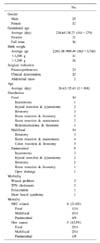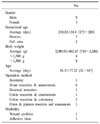Abstract
Purpose
Necrotizing enterocolitis (NEC) is a severe inflammatory disorder of the intestine, causing high mortality and morbidity. We investigated the single center experience about the operative indication, treatment method, and mortality in NEC.
Methods
The medical records of infants (<1 year old) who underwent the operation due to complications of NEC at the Asan Medical Center from Jan 1997 to Dec 2007 were retrospectively reviewed.
Results
Among 49 patients (M : F = 34 : 15), 37 underwent the operation at acute phase of NEC, average 26.43±35.43 days after birth (3~168), due to pneumoperitoneum in 23, clinical deterioration in 12 and abdominal mass in 2. Average gestational age was 234.64±38.27 days (161~279) and birth weight was 2,061.38±999.49 g (563~3,740). The extent of necrosis was classified grossly as focal in 14 cases, multifocal in 14 and panintestinal in 9 and the operative methods were enterostomy in 30 patients, resection and anastomosis in 6 and open drainage in 1. Thirteen patients (35.1%) were expired - 8 (21.6%) died of necrotizing enterocolitis and 5 died of other causes. The other 12 patients underwent operation for stricture after NEC at average 81.17±77.22 days after birth (32~317). Average gestational age was 240.83±34.4 days (173~280) and birth weight was 2,089.83±862.47 g (710~3,200). Eight patients underwent resection and anastomosis including stricture and 4 patients underwent enterostomy.
Figures and Tables
References
1. Moss RL, Dimmitt RA, Barnhart DC, Sylvester KG, Brown RL, Powell DM, et al. Laparotomy versus peritoneal drainage for necrotizing enterocolitis and perforation. N Engl J Med. 2006. 354:2225–2234.
2. Henry MC, Moss RL. Current issues in the management of necrotizing enterocolitis. Semin Perinatol. 2004. 28:221–233.
3. Pierro A. The surgical management of necrotising enterocolitis. Early Hum Dev. 2005. 81:79–85.
4. Panigrahi P. Necrotizing enterocolitis: a practical guide to its prevention and management. Paediatr Drugs. 2006. 8:151–165.
5. Kosloske AM. Surgery of necrotizing enterocolitis. World J Surg. 1985. 9:277–284.
6. Holman RC, Stehr-Green JK, Zelasky MT. Necrotizing enterocolitis mortality in the United States, 1979-85. Am J Public Health. 1989. 79:987–989.
7. Rowe MI, Reblock KK, Kurkchubasche AG, Healey PJ. Necrotizing enterocolitis in the extremely low birth weight infant. J Pediatr Surg. 1994. 29:987–990.
8. Patel JC, Tepas JJ 3rd, Huffman SD, Evans JS. Neonatal necrotizing enterocolitis: the long-term perspective. Am Surg. 1998. 64:575–579.
9. Nadler EP, Upperman JS, Ford HR. Controversies in the management of necrotizing enterocolitis. Surg Infect (Larchmt). 2001. 2:113–119.
10. Sparnon AL, Kiely EM. Resection and primary anastomosis for necrotising enterocolitis. Pediatr Surg Int. 1987. 2:101–104.
11. Jo HJ, Cho YH, Kim HY. Clinical factors affecting postoperative mortality in necrotizing enterocolitis. J Korean Surg Soc. 2006. 70:390–395.
12. Pierro A, Hall N, Ade-Ajayi A, Curry J, Kiely EM. Laparoscopy assists surgical decision making in infants with necrotizing enterocolitis. J Pediatr Surg. 2004. 39:902–906.
13. Lee JS, Polin RA. Treatment and prevention of necrotizing enterocolitis. Semin Neonatol. 2003. 8:449–459.
14. Cass DL, Brandt ML, Patel DL, Nuchtern JG, Minifee PK, Wesson DE. Peritoneal drainage as definitive treatment for neonates with isolated intestinal perforation. J Pediatr Surg. 2000. 35:1531–1536.
15. Blakely ML, Tyson JE, Lally KP, McDonald S, Stoll BJ, Stevenson DK, et al. Laparotomy versus peritoneal drainage for necrotizing enterocolitis or isolated intestinal perforation in extremely low birth weight infants: outcomes through 18 months adjusted age. Pediatrics. 2006. 117:e680–e687.
16. Rees CM, Hall NJ, Eaton S, Pierro A. Surgical strategies for necrotising enterocolitis: a survey of practice in the United Kingdom. Arch Dis Child Fetal Neonatal Ed. 2005. 90:F152–F155.
17. O'Connor A, Sawin RS. High morbidity of enterostomy and its closure in premature infants with necrotizing enterocolitis. Arch Surg. 1998. 133:875–880.
18. Cogbill TH, Millikan JS. Reconstitution of intestinal continuity after resection for neonatal necrotizing enterocolitis. Surg Gynecol Obstet. 1985. 160:330–334.
19. Singh M, Owen A, Gull S, Morabito A, Bianchi A. Surgery for intestinal perforation in preterm neonates: anastomosis vs stoma. J Pediatr Surg. 2006. 41:725–729.
20. Weber TR, Lewis JE. The role of second-look laparotomy in necrotizing enterocolitis. J Pediatr Surg. 1986. 21:323–325.
21. Vaughan WG, Grosfeld JL, West K, Scherer LR 3rd, Villamizar E, Rescorla FJ. Avoidance of stomas and delayed anastomosis for bowel necrosis: the 'clip and drop-back' technique. J Pediatr Surg. 1996. 31:542–545.
22. Moore TC. Successful use of the 'patch, drain, and wait" laparotomy approach to perforated necrotizing enterocolitis: is hypoxia-triggered "good angiogenesis" involved? Pediatr Surg Int. 2000. 16:356–363.
23. Hunter CJ, Chokshi N, Ford HR. Evidence vs experience in the surgical management of necrotizing enterocolitis and focal intestinal perforation. J Perinatol. 2008. 28:Suppl 1. S14–S17.




 PDF
PDF ePub
ePub Citation
Citation Print
Print




 XML Download
XML Download